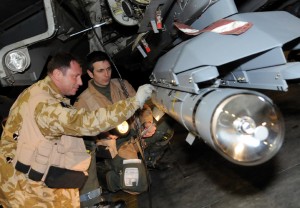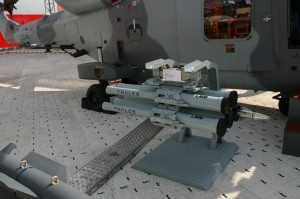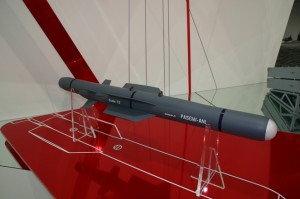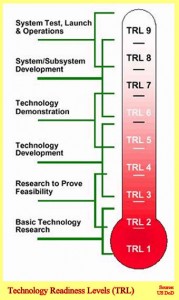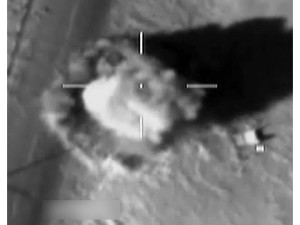IAN STRACHAN reports from the Weapon Systems and Technology post-Strategic Defence and Security Review Conference, organised by the RAeS Weapon Systems and Technology Group.
This is a full article published in Aerospace International: May 2011
In February, the Weapon Systems Group of the Royal Aeronautical Society organised a conference at the MoD test site at Boscombe Down to review the situation after the publication of the UK Government’s Strategic Defence and Security Review (SDSR). Steve Wilkinson of QinetiQ, head of the Boscombe Down site and director of aviation facility services, welcomed the delegates and speakers.
The keynote speaker was Peter Luff MP, Minister of State for Defence Equipment. This conference is timely, he said, because it was one of the first after the publication of the SDSR. He warned that “it’s not over yet” and more tough decisions were required. He said that, due to the inherited ten year £38bn ‘black hole’ in MoD finances, there might have to be more defence reviews. He supported government actions to strengthen the nation’s economy and said that “a weak economy is a security and defence liability.” Even so, “our forces will continue to be the most versatile in the world” and have “the best equipment they have ever had”. When there was an exceptional need, the system of Urgent Operational Requirements (UORs) worked well, with 37% of such equipment delivered early, showing that “we can do it when we need it”.
Future force 2020
The long-term object, he said, was an affordable defence capability from the end of the decade, the concept being “future force 2020” in which various threads would come together. He regretted the retirement of the Harrier but the government was presented with a situation where the defence budget was over-committed, particularly in high-specification equipment. In the case of the Nimrod MRA4, “when a project is out of control, we will cancel it” he said with some force. For reasons such as this, parliament’s Public Accounts Committee (PAC) had complained about the MoD financial imbalance. As a result, a Major Projects Review Board (MPRB) had recently been established.
Turning to the UK defence industry, it needs to continue to invest in R&D and he praised initiatives such as the Defence Technology Centre and the NiteWorks project. He mentioned the area of complex weapons (CW), and more generally, the role of simulation. On the latter, he said that the role of simulation in defence was often not understood in other government departments. On the JSF future fighter aircraft, he said that UK aspects of the project were sound and our relations with the US were good. On exports, if government delegations were going abroad, it was natural that defence people went as well. If we don’t do this, he said, the defence equipment vacuum would be filled by others. Finally, said the Minister, a Defence Green Paper was available and he encouraged people to comment on it.
Sir Brian Burridge presented on post-SDSR warfare, and asked whether ‘manoeuvre warfare’ would become a lost art or the least appropriate scenario of the future. He noted the concept of ‘future force 2020’ but pointed out that, on the way, there would be ‘interim force 2015’ in which there would be capability gaps.
He then compared this situation with the conditions of the 2003 Iraq war, Operation Iraqi Freedom, in which he commanded the UK contingent. This was the most recent example of UK participation in large-scale high-intensity manoeuvre warfare. It had a combination of precision weapons, networked information, good co-operation between land and air forces, and agile command and control. This was used to maximum effect in a joint campaign within which air power played a pivotal role, the US operating some 1,600 aircraft compared to 140 from the UK. The UK force consisted of 113 fixed-wing aircraft and 27 helicopters, some 8,100 RAF personnel being involved. The US used about 29,000 weapons compared to the UK’s 920, of which 85% were precision-guided. “They did fire back,” said Sir Brian, and there were over 28,000 examples. Turning to equipment procurement in a war situation “we always rely on UORs”. In the 2003 war, some £500m was spent on equipment for UK forces that was procured through the UOR process. Some 60% was for equipment not already in inventory and the other 40% to accelerate existing programmes. An example of the latter was the MBDA Storm Shadow cruise missile which was put into service early and proved effective. Turning from weapons to more general matters, the ISTAR function was vital in the 2003 operation.
Off the shelf not the answer
Looking to the future, capabilities that were readily available in 2003 can no longer be taken for granted as a natural element of the UK frontline. For instance, there are questions about ISTAR with the demise of Nimrod MRA4 and the future retirement of the RAF Sentinel R1 surveillance system. On the UK Defence Green Paper, “the 2015 interim position worries me. How well will the economy recover and will the military get the resources to fill the 2015 gap?”, he asked. He suggested that the UK needs both high technology and critical industrial mass, important because, in the long term, the policy of current allies may change. “No major military power has succeeded without having its own defence industrial base,” he said. Buying off the shelf (OTS) was not the answer and a previous Chief of Defence Staff had said that: “OTS equipment is probably legacy equipment.” OTS acquisition “sits ill with a systems approach”, he said, and does not support small and medium-size enterprises (SMEs). Looking at overseas purchases: “If you take your intellectual property from offshore, you are taking a big risk.” However, bespoke UK-only designs were costly and he mentioned the UK version of the Chinook helicopter, different to standard versions and therefore considerably more expensive. Looking at the UK defence industry, production-runs for UK forces were small and therefore exports were required if our industry was to be sustained.
Sir Brian’s final question was whether we were to be a first-rank military power. He concluded that unless changes are made, we could be heading towards second-class status and that our ability to carry out manoeuvre warfare might become an “inadvertently lost art.”
Complex weapons
Partnering for complex weapon systems was addressed by Alan Nicholl, director of weapons in the Defence Equipment and Support (DE&S) area of UK MoD, and Steve Wadley, managing director of the UK branch of missile-manufacturer MBDA. There was a strategic requirement for CW (complex weapons), said Nicholl, and went on to describe the concept of package management. This is where several projects are grouped together into a ‘package’ under unified management. This was said to give more flexibility than keeping individual projects separate from each other. The concept of ‘portfolio funding’ was used where money was allocated to a package rather than individual projects, again for reasons of flexibility. For the future, joint working with allies on major CW projects was desirable, and agreements between Prime Minister Cameron and French President Sarkozy were mentioned. “We need to work more closely with our French colleagues,” he said.
Steve Wadley continued, giving a contractor’s perspective, and said that the UK CW sector was involved in projects worth £1·2bn. He referred to the QinetiQ Weapons Technology Centre and mentioned missiles such as the Dual Mode Brimstone AGM, Fire Shadow UAV, Meteor AAM and Sea Viper SAM. For the future, there were programmes such as the Common Anti-Air Missile (CAAM), Future Air-to-Surface Guided Weapon (FASGW) and the longer-range weapon known as Selective Precision Effects At Range (SPEAR).
Testing and evaluation
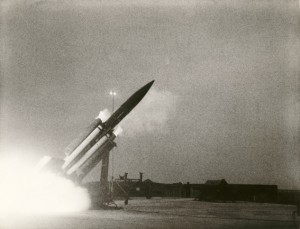
The Bristol Bloodhound SAm was probably the last UK weapon system to be tested entirely 'live'. (RAeS/NAL).
Post-SDSR research and technology (R&T) was covered by Graham Jordan of RUSI. He pointed out that the last UK weapon system to be tested entirely live, was probably the Bloodhound SAM system, developed in the late 1950s. Now, much modelling and simulation is used in testing and some complex systems and weapons can only be used ‘live’ in war situations. The SDSR consultation paper identifies technologies in which the UK needs to retain a national capability. However, he noted that it does not include the assessment of complex systems. Some equipment can be evaluated by direct testing but there are others whose capability in peacetime can only be inferred by the use of computer models and complex test rigs. The latter include complex weapons, communication and sensor systems, all of which must be assessed against sensitive threats. For this, expertise and facilities are needed in the UK. It is also important that the vendor is open about the system being offered, and prepared for any investigation required by the MoD. There should be no ‘sealed black boxes’ or un-disclosed algorithms, he said, so that flexibility can be preserved and adjustments can be made quickly as conditions change during battle.
For the future, it appears that MoD will manage its technology and industrial policies by roles, such as land, sea, air, C4ISTAR and complex weapons. While that may be fine for relationships with industry, he said, it is poor for structuring a coherent R&T programme. For example, radar and electro-optical technologies and their countermeasures span all of these areas and a technology-based approach was also needed.
Technology readiness levels
Addressing technology readiness levels (TRLs) he said that it appears that MoD’s policy is to fund research up to about TRL 4. Above this level, industry is expected to find its own funding to mature technologies, because its bids for equipment must be based on mature technology. He noted that this is potentially a large bill for industry, and asked that MoD be transparent on future research spending, to give industry confidence and to avoid unnecessary rumours.
‘Taming the tiger — reducing costs while sustaining capability’ was presented by Professor David Oxenham, chief systems engineer of the Defence Science and Technology Laboratory (DSTL), an executive agency of the UK MoD. He suggested that the solution was to take a ‘systems approach’. Case studies show that it is possible to make intelligent use of science and technology (S&T) to achieve the aim. However, he pointed out that we need to look at the whole problem and explore the sometimes complex connections between systems. Technology provides one route to a solution, he said, but other routes can be exposed if we use the skills and knowledge that are available in both MoD and industry, and “sharing a problem can identify innovative solutions.” On the tendency to prolong the life of existing systems, he advised caution because, often, “old technology is expensive to manage.”
Bridging the tech gap
‘Bridging the gap: research planning to exploitation for complex weapons’ was the subject of Dr Adrian Britton, technical manager, Weapons and Energetic Services, QinetiQ. He described the QinetiQ-co-ordinated Weapons Technology Centre (WTC) for the development and demonstration of technology for future complex weapons (abbreviated as ‘CW mid-TRL R&T’). A particular remit is to bridge the gap that often blocks the transition from research into hardware. MoD and industry will jointly formulate and prioritise future R&T, and will oversee the delivery of R&T through industry and MoD research programmes. It is hoped that increased visibility of the potentialities of future complex weapons will focus and justify investment, both for suppliers and customers.
‘Complex weapon stockpile and manufacture analysis was covered by Jarrod Cornforth, an operational analyst for the MoD DSTL, and David Barlow, senior principal operational analyst for the UK branch of the MBDA company. They described Team Complex Weapons (TCW) which is a partnership between MoD and MBDA to deliver a portfolio of complex weapons over the next ten plus years. An analysis was conducted jointly between DSTL and MBDA on how a range of manufacturing options could respond to a variety of demands for future weapons. The analysis included decisions on the amount of stockpiles to be kept, through an evaluation of the balance between cost and risk. A flexible approach to stockpiling complex weapons has been developed. Under this, only a small stockpile of each weapon is kept, which is replaced after use of weapons by ‘surging’ new manufacture. This approach will alter procedures in the military by reducing spares holdings and by manufacturers in keeping the capacity to increase production at any time.
Aerospace International Contents - May 2011
News Roundup - p4
Pacific skies - p10
Light aviation down under
90 not out -p 12
Report from the 2011 Avalon Australian Air Show
Gatwick reloaded - p 16
How the airports new owners are revamping the passenger experience
Con air? - p18
Is the growth in Pay2Fly good for aviation?
A new synthesis in aviation safety - p 22
Time for a rethink on avoidable accidents?
Weapons post-SDSR - p26
A report on the RAeS defence conference
Europe looks to the future - p 30
A report from the Aerodays meeting in Madrid
The last word - p34
Keith Hayward assesses technology acquisition
Penny wise, pound foolish?
‘Complex weapons — the impact of short-term decisions on long-term savings was addressed by Dominic Oemis, a senior analyst for the Atkins engineering and design consultancy. There is a requirement for a modular family of complex weapons under Team-CW (TCW). There is also a requirement to evaluate the cost-effectiveness of a future weapon procured from outside the TCW process. Atkins has been tasked to establish the costs of the whole TCW portfolio, taking into account individual system projects. A cost model has been produced that not only captures the costs of individual projects but also the relationships between all projects. This includes the potential re-use that could be achieved when compared to a traditional approach to acquisition. This model will be used to analyse the impacts of different procurement, budget and time options, and will take the MoD planning and approval system into account. The aim is to ensure that decisions taken at project level are made with global objectives in mind, so that overall capability may be preserved within a reduced budget.
‘The role of simulation in the development and application of air power’ was covered by Gordon Woolley, a retired RAF Group Captain and manager of the Tactical Control Centre at CAE’s Helicopter Aircrew Training Centre at RAF Benson. Technological progress, he said, has made air power ever more capable, with greater scope, pace and precision than ever before. However, increased capability leads to difficulties in training realistically. Peacetime training using live assets has limited value in preparing crews for deployed operations in other parts of the world. The expeditionary nature and worldwide commitments of air forces require a still broader range of skills to be trained and maintained.
He concluded that simulator-based training and the use of synthetic environments (SE) can provide realistic, real-time training for scenarios anywhere in the world. Simulators and other computer-based training aids can be networked together and in training exercises can immerse crews of different aircraft and ground forces in interactive synthetic theatres of war (STOW). Live assets can also be included through network links. Synthetic training has now overtaken training using the real equipment in both operational realism and training effectiveness. Finally, on training costs, the use of high-quality simulators for aircraft like the Chinook and Merlin was some ten times less costly than using the aircraft itself and, on the Puma, a less complex aircraft, about five times less expensive.
Unfortunately there is not space in this article to summarise several other presentations, but they are available from the RAeS on the conference proceedings’ CD-ROM.
Conclusion
This was the first major RAeS conference to address the UK MoD post-SDSR situation, with significant keynotes from defence equipment minister Peter Luff and Sir Brian Burridge. Both raised cautions, particularly about the interim UK defence position between now and ‘future force 2020’. Other distinguished speakers amplified the consequences of the SDSR and suggested improvements in management of research, development and procurement. Some areas important for the future include package management and portfolio funding, simulation, team complex weapons, technology readiness levels and the new Weapons Technology Centre. A positive note on costs was that training and operational preparation using simulation technology is not only effective but also significantly less expensive than using front-line equipment for the same purposes.
This is a full article published in Aerospace International: May 2011. As a member, you recieve two new Royal Aeronautical Society publications each month - find out more about membership.



